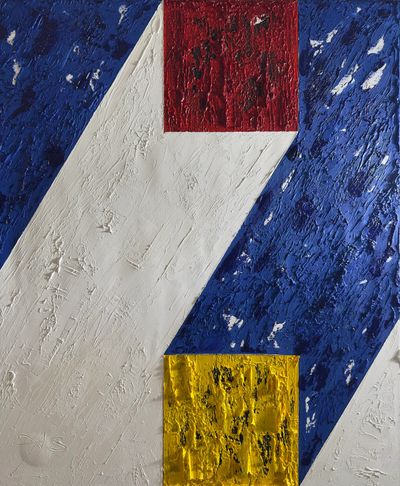The Russian-Ukrainian War
Tibor Babos
War Collection
Paradox Constructivism / Constructive Unrealism
2025
60 x 50 cm (23.6 in X 19.6 in)
Oil on 3D+ Canvas
Budapest
The Russian-Ukrainian War (2025) by Tibor Babos is a stripped-down geometry of grief and force — a composition that speaks the unspeakable through silence, through form. As part of the War Collection, the painting transforms abstraction into confrontation, turning the legacy of Constructivism on its head. Here, Babos’s Paradox Constructivism operates with brutal clarity, combining the visual language of utopian modernism with the lived trauma of contemporary geopolitics.
The composition is deceptively clean: a sharp white diagonal slices across a field of deep, bruised blue. Anchored to this diagonal are two heavy squares — one red, one yellow — positioned like oppositional sentinels in a cold, formal standoff. Yet within this hard geometry lies a battlefield. The red square bleeds quietly into the canvas, textured with layers of aggression, ideology, and decay. It is the aggressor — Russia — rendered not as emblem but as weight. Above the white band, it looms. Below, the yellow square hums with battered brightness, scarred but electric. It stands for Ukraine — not in triumph, but in endurance.
Babos’s manipulation of surface is as political as it is painterly. Each square is not merely colored, but carved and wounded. The oil is dragged, scraped, heaped — a technique that turns pigment into terrain. The red is not a clean hue; it is a corrupted one, textured like history. The yellow is not hopeful; it is trembling, vivid, necessary. The blue swath that cradles and crushes the composition is heavy with impasto, like night sky pocked with explosions. This is a map made of memory and oil.
The white diagonal — perhaps the most ambiguous and evocative element — slices through this field like both a border and a blade. It could be a path, or a wound. It evokes clarity but offers no comfort. It is neither neutral nor passive; it forces separation, draws opposition, defines the very geometry of war. It introduces rhythm into stasis, direction into confrontation. Its very starkness carries unease.
Color, for Babos, is never innocent. Red, yellow, blue, and white — these are the components of national flags, systems of belonging, structures of pride. But here, they’re stripped of triumph. They don’t wave; they weigh. They compress. The chromatic language becomes a cipher of power and suffering, of aggression and defense, of a world where symbols kill and survive.
This work operates on two registers at once: one visual, one visceral. On the surface, it recalls the coolness of Malevich or El Lissitzky — echoes of Suprematism and Constructivism in the rigid spatial order. But Babos ruptures that lineage. He refuses the utopian aspirations of early abstraction, injecting it instead with dread, specificity, and pain. This is not the geometry of progress. It is the geometry of collapse.
Created amid an ongoing and unresolved war, The Russian-Ukrainian War becomes both document and demand. It does not narrate or explain; it insists. Its minimalism is not aesthetic detachment, but sharpened focus. In an era of overexposed images and numbed attention, Babos reduces the war to its primal forms and elemental consequences. This abstraction doesn’t escape reality — it heightens it.
As with all of Babos’s Constructive Unrealism, the contradiction is the point. Clean forms, chaotic implications. Beautiful surfaces, brutal meaning. The painting becomes a paradox in paint: ordered and disrupted, symbolic and searing. It offers no resolution, only the task of reflection. It refuses to let the viewer look away.
The Russian-Ukrainian War is a landmark in Babos’s ongoing inquiry into the ethics of form and the politics of abstraction. It is not a protest, not a sermon, not a spectacle. It is a wound given structure, a silence given geometry. In this sense, it is one of the most urgent functions art can serve — to reframe crisis not as an image, but as an experience.

CONSTRUCTIVE UNREALISM
Budapest / New York / Miami
Copyright © 2025 CONSTRUCTIVE UNREALISM
All Rights Reserved.
This website uses cookies.
We use cookies to analyze website traffic and optimize your website experience. By accepting our use of cookies, your data will be aggregated with all other user data.
